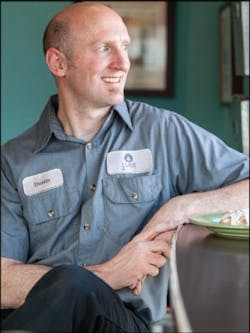There’s an audible cringe in Dustin Olde’s voice when he says the word.
Gimmick.
He’s heard it often—too often, he says. Ever since founding Lube & Latte—his hybrid coffee-shop-meets-auto-repair-shop in Lakewood, Colo.—in 2006, Olde has had to hear from the doubters.
It’s a gimmick. It’s too contrived. It’s destined to fail.
For the first four years, Olde fought to keep those words out of his head, as he plugged away at making Lube & Latte into the business he dreamt it could be. But, for four years, it became harder and harder to ignore the criticism, especially as the business struggled to gain solid financial footing.
It was 2010, and Olde’s shop was losing money. It was “caught in no-man’s land,” he says.
“We were three or four years into it, and we were having an identity crisis,” Olde says.
“We had this coffee shop mindset, and we wanted it to be quick and fast,” he adds. “But we weren’t as quick or cheap as the Jiffy Lubes or Grease Monkeys, and we weren’t doing the big jobs other shops were. We were trapped in the middle in this place where we had to decide: What are we?”
The only thing Olde was sure of was what the shop wasn’t: a gimmick. He believed in the concept. He believed that it could be successful. And he was determined to prove it.
The Backstory
Olde had a clear vision of what the shop would someday look like: Customers lined up at the counter’s two registers—one side coffee, the other cars—in a perpetual turnstyle of business for the shop. He’d use the customer-centric, relationship-oriented atmosphere of the independent coffee house to provide a welcoming waiting area, one customers would hang out in whether getting their vehicles serviced or not. Auto service would be the true profit center.
Lube & Latte
Lakewood, Colo.
Size: 1,800 square feet
Staff: 5 (3 technicians, 1 service advisor, 1 barista)
Average Monthly Car Count: 350
Annual Revenue: $800,000 (excludes revenue from cafe)
Olde had worked in both industries before opening Lube & Latte. He worked his way through college as a barista in Portland, and he saw the way he could connect with customers on a daily basis. He learned the value of relationship selling and how it translated into repeat business and consumer loyalty.
Then, he witnessed the stark contrast of what the automotive industry traditionally offered.
A Denver native, he moved back to his hometown and turned to auto repair.
“I wanted to own a business someday, and I was looking at profitable businesses that also give you a real opportunity to help people,” he says. “I thought auto repair was a great fit.”
He went back to school and trained to be a technician, eventually beginning work at a Firestone location before becoming a service writer for a local Pep Boys store.
The experiences left him unfulfilled.
“It just got me thinking about those two [work] experiences and a way to combine what made them both successful,” he says. “With both, people are looking for a better experience, better service.
“I just thought: I bet people will enjoy waiting for their oil change just a little more if they could get a really good latte right there.”
The Problem
The concept was sound, Olde says. It was the execution and the reality that was a struggle.
Olde found an available repair facility just west of Denver in Lakewood, a corner lot with an 1,800-square-foot building plopped onto a decently sized parking lot. He retrofitted the 400-square-foot former lobby into a coffee shop, painting the walls teal and putting in a front counter with a glass pastry case. He set up tables, chairs and couches. He turned the former office (behind the counter) into a barista station with a full range of offerings.
He hung two menus—one for the cafe offerings, one for auto service—above the counter.
A brick wall helped lend some sound-proofing between the coffee shop and the shop’s three fully-equipped bays. He cut a dropbox into the wall to quickly pass keys between the counter and techs.
Intentionally, he didn’t leave himself any office space; he wanted everyone in the front of the shop to be in the open and able to connect with customers.
The vibe, the atmosphere, the look—it was all what Olde envisioned.
Sales were not.
The bays were usually full, but with a two-person service staff, the work wasn’t turning over quickly enough to keep up with a quick-service business model.
“I put a lot of effort into the coffee shop side, and probably not enough in the repair side,” he says. “We were sort of in this in-between area, where we couldn’t get the work load through fast enough to be profitable with it.”
“I sort of came to realize that, even though the margins are much better with coffee, I really needed to look at the repair side as the real way to make money in this,” he says.
Olde had to decide what his business was: a coffee shop that does auto repair, or a repair shop that also sells coffee. He chose the latter.
The Solution
Where many traditional shops can’t rely solely on word-of-mouth referrals in today’s digital age, Lube & Latte had a distinct advantage over its competitors. Unlike all other shops in the area, Olde’s business actually brought in real, walk-in traffic—people came to the shop regardless of whether their vehicle was being serviced or not.
EXPERT ADVICE
Rick White
President
One Eighty Business Solutions
Add-on services or profit centers can create a unique opportunity for shops to better retain, attract and service customers—in addition to bringing your business increased revenue. However, industry consultant Rick White says there’s a lot that goes into making an add-on successful.
I’ve always liked the thought of a coffee shop and a repair shop being mixed. It would be very cool if it worked, but here’s the problem: If you’re trying to do something like a Starbucks in your shop, your business has to be really setup for people waiting. Most aren’t. So, if you don’t have a lot of repair customers waiting, then you have two totally separate businesses—each with very separate issues.
For me, I would stay clear of stuff I’m not comfortable with. If it’s not my core business, I’m not going to go branching out. Stay auto-related: Go after auto sales, technology upgrades, detailing or quick lubes.
From my perspective, I would do quick lubes. It has to be managed properly, but it often gives the shop the best return on its investment. It also shows customers that you’re looking out for their needs and it plants seeds for future business. It has the potential to be a really nice add-on for a service department.
Coffee was the shop’s best marketing tool, and that was going to be the starting point for rebuilding (and rebranding) his business.
Olde hired on two full-service technicians, who had previously worked at local dealerships. He put an existing tech, who had only worked on quick lube work, on an apprentice-style path to learning full-service repair. And he moved the other auto team member to a full-time service advisor role that meshed well with his vehicle knowledge and “people-person” mentality, Olde says.
Then, he redid the shop’s signage, inside and out, to reflect its full-service approach to repair.
“It was one of those things that we had the people in there, we were already maxed out with 25 cars a day or so,” he says. “We had the people in there already, so they start seeing the signs, they start asking about it, and we slowly worked to transition their mindset.”
With the new team in place, Olde simply started taking on work that customers asked about or his team found when inspecting vehicles.
He and his service advisor sold work each job with a focus on educating the customer. He developed a three-tiered inspection system broken down by how critical each element was to the vehicle’s performance and safety, and he worked to teach customers the value that each item could provided.
“I knew that if we hard-sold someone, we might get those jobs that day,” he says. “But the idea needed to be keeping them as long-term customers that are coming back. We wanted long-term plans with each customer for each vehicle. We wanted to be the long-term shop they trusted.
“If we could earn that trust, and keep them coming back, we could turn this thing around.”
The Aftermath
Slowly, Olde’s work mix fully flipped. In 2010, the shop did roughly 90 percent quick-service work, almost entirely oil changes. In 2014, just 20 percent of the shop’s auto-related revenue would fall under that quick-service label, and sales have nearly doubled to above $800,000.
With just five total people on staff, including a full-time barista, and throwing in the coffee shop’s healthy annual sales approaching $100,000, and Lube & Latte has found its financial security, Olde says. It’s profitable, and has caught on with a large customer base. It was given the “best customer service” award from Denver-area magazine, 5280, three straight years. The shop has a two-week wait for larger jobs. He’s now looking at expanding to a second facility—one that would serve as a satellite location, focused entirely on full-service repair.
“We do a lot of traffic through here, more than I think people would believe given what it is,” he says. “We’ve worked hard to tweak this model, and we’re really finding that right mix now.”
The Takeaway
Olde hopes his story shares two important points. First, a business needs to create its own identity. There are a lot of repair shops out there, he says. What do you do to differentiate yourself?
“And, second, people really have to open their minds a bit,” he says.
“This isn’t the same industry as 25 years ago, and we’re not serving the same customers,” Olde, 41, adds. “You need to get creative and find ways to bring business in and grow and increase your market share.
“For us, we did that with lattes and coffee and having that additional level of customer service. We had to find that right medium, but it is a business strategy that works for us now. We have a long-term, viable business. This isn’t a gimmick. This is what we are.”
About the Author

Bryce Evans
Bryce Evans is the vice president of content at 10 Missions Media, overseeing an award-winning team that produces FenderBender, Ratchet+Wrench and NOLN.
